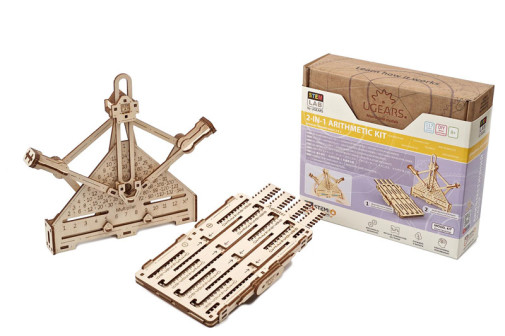We use cookies to make your experience better. To comply with the new e-Privacy directive, we need to ask for your consent to set the cookies. Learn more.
Ugears 3D Wooden Mechanical Model Arithmetic Kit
Find out how the Mechanical Addiator and Mechanical Multiplier work
The Mechanical Addiator is a compact arithmetic machine (or adding machine) that works by moving gear racks, using a stylus included in the kit. By moving the sliding racks, marked with arrows and numbers from 0 to 9, you can add and subtract numbers.
The Mechanical Multiplier is a flat hinge mechanism that accomplishes binary operations on numbers. By moving the dual slider, you can multiply and square numbers from 1 to 12, making the multiplication table fun.
Who invented the Mechanical Addiator and Mechanical Multiplier, and when?
The UGEARS Mechanical Addiator is a DIY wooden model kit based on an addiator that was invented by a St. Petersburg music teacher, Heinrich Kummer, in 1846. Its simple design and compact size made it a popular mathematical tool in its time. Today this simple, fun mechanism is part of UGEARS' outstanding STEM Lab collection.
The UGEARS Mechanical Multiplier is a fun wooden 3D puzzle based on a children's toy, "Consul the Educated Monkey," invented in 1915 by William Henry Robertson, an American high school math teacher. Robertson applied for a patent for a toy that ingeniously uses a hinged mechanism to perform simple multiplication, designed "to stimulate children's interest in the study of numbers."
Uses for The Mechanical Addiator and Mechanical Multiplier
The Mechanical Addiator is used to add and subtract numbers. To do this, the user enters a numeric value using the stylus, then uses the stylus to enter a second number. The device then shows the result of the desired mathematical operation, according to where the second number was entered (top row for addition, bottom row for subtraction). But the Addiator is not limited to addition and subtraction—you can also use it to multiply and divide.
The Mechanical Multiplier is a simple and interesting way to learn the "unloved" multiplication tables from 1 to 12 and to understand the simple principle of hinge-lever mechanisms. When the two sliders are moved to various numbers, you will see their product displayed in the window above.
Components of the Mechanical Addiator and Mechanical Multiplier, and how they work
The Mechanical Addiator consists of a housing in which four rails or racks are set, with printed values on them. A stylus is used to input values. Numbers are entered from cam slots, and the results are displayed in four center windows. Before starting an addition/subtraction operation using the stylus, the racks should be set so that all windows display "0". The value of the number on which the operation is performed is first entered using the top row of slots; the top slots are then used to add a second number, while the bottom ones are used for subtraction.
The Mechanical Multiplier consists of two sliders that move along a number line (1-12), and a lever system that transfers the movement of the sliders to a "Results" window, which moves along a value field. As you move the two sliders between different number values, the product of their multiplication will appear in the "Results" window. In order to multiply a number by itself (to square it), the right slider should be moved to the extreme right position and fixed at the "X²" symbol.
Fully-functional mechanical models from nothing but laser-cut plywood? It sounds sketchy, and perhaps even fragile, but there's nothing amateur about these high-quality kits. Each box contains several sturdy wooden sheets of laser-cut pieces, with each piece numbered according to its chronological use in the instruction booklet. The booklet itself is the veritable pice de resistance of the kits, utilizing full-color 3D illustrations, "magnified" steps for small pieces, a straightforward labeling system, and helpful symbols for tricky steps. Once completed, the scale model operates just like the real thing, mimicking behavior as closely as 1/8th-inch plywood (and a few extra bits) can. Safes have combination locks, engines push pistons, and vehicles feature functioning transmission and rubber-band powered motors. All components are natural and sustainably-sourced. Oh, and did we mention the holy grail of model construction? No glue required.
The kits provide a range of complexity (between 1-12 hours), with 14 being the youngest recommended age for completing all models solo. With limited adult supervision or model-making experience, most kits can be completed by those as young as 11 or 12 and are durable enough for extended use. All models are beautifully designed and just about the right size for pretend play, and they can even be painted using watercolors or other thin paints! And of course, at the forefront of each and every lovingly crafted kit is a dedication to mechanics: you're not just putting it together; you're learning how it functions.
| Product Format: | Other |
|---|---|
| Brand: | UGears |
| Grades: | 9-AD |
| EAN/UPC: | 4820184121256 |
| Length in Inches: | 7.5 |
| Width in Inches: | 8 |
| Height in Inches: | 2.5 |
| Weight in Pounds: | 1.15 |

